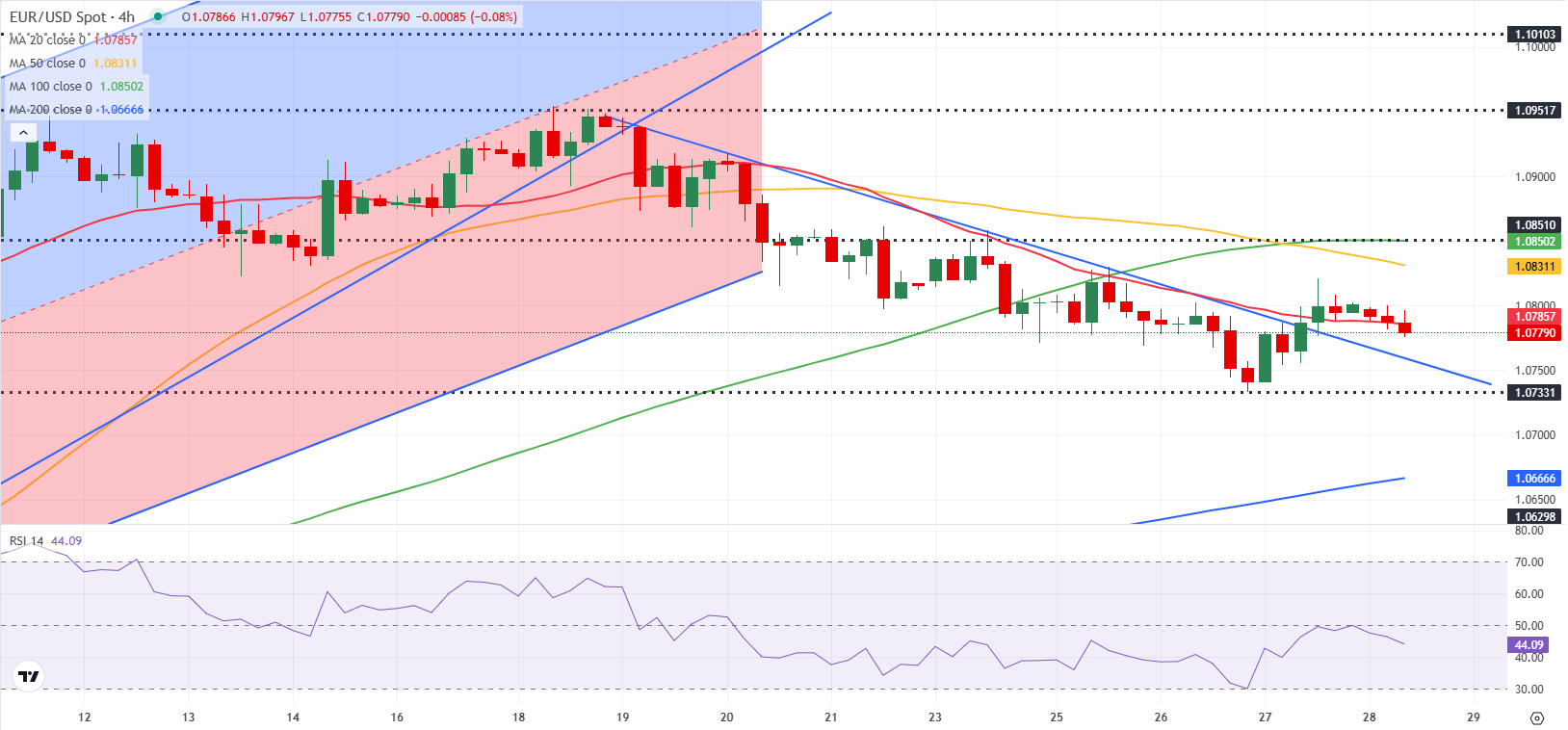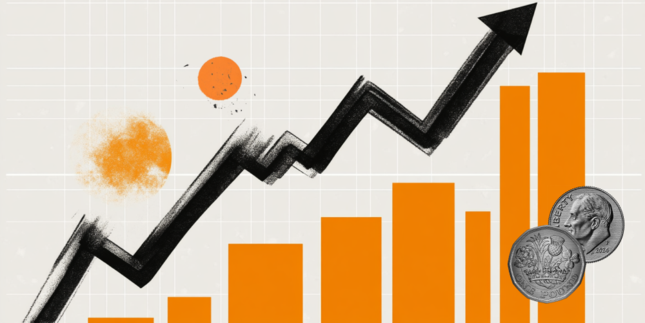- EUR/USD struggles to build on Thursday's recovery gains.
- The US economic calendar will feature February PCE inflation data.
- The risk-averse market atmosphere could continue to weigh on the pair.
EUR/USD gained nearly 0.5% on Thursday and snapped a six-day losing streak. The pair, however, loses its traction and trades in the negative territory below 1.0800 on Friday, pressured by the risk-averse market atmosphere.
Euro PRICE This week
The table below shows the percentage change of Euro (EUR) against listed major currencies this week. Euro was the weakest against the Australian Dollar.
| USD | EUR | GBP | JPY | CAD | AUD | NZD | CHF | |
|---|---|---|---|---|---|---|---|---|
| USD | 0.36% | -0.23% | 0.81% | -0.24% | -0.40% | 0.24% | -0.10% | |
| EUR | -0.36% | -0.71% | -0.08% | -0.56% | -0.77% | -0.08% | -0.43% | |
| GBP | 0.23% | 0.71% | 1.03% | -0.47% | -0.09% | 0.64% | 0.18% | |
| JPY | -0.81% | 0.08% | -1.03% | -1.05% | -1.22% | -0.56% | -0.93% | |
| CAD | 0.24% | 0.56% | 0.47% | 1.05% | -0.10% | 0.47% | 0.13% | |
| AUD | 0.40% | 0.77% | 0.09% | 1.22% | 0.10% | 0.70% | 0.36% | |
| NZD | -0.24% | 0.08% | -0.64% | 0.56% | -0.47% | -0.70% | -0.28% | |
| CHF | 0.10% | 0.43% | -0.18% | 0.93% | -0.13% | -0.36% | 0.28% |
The heat map shows percentage changes of major currencies against each other. The base currency is picked from the left column, while the quote currency is picked from the top row. For example, if you pick the Euro from the left column and move along the horizontal line to the US Dollar, the percentage change displayed in the box will represent EUR (base)/USD (quote).
The US Dollar (USD) struggled to find demand on Thursday and allowed EUR/USD to push higher as US President Donald Trump's announcement of auto tariffs reminded investors of a potential downturn in the US economic outlook.
Early Friday, markets cling to a cautious stance, helping the USD stay resilient against its rivals. At the time of press, US stock index futures were down between 0.3% and 0.6%.
In the second half of the day, the US economic calendar will feature the Personal Consumption Expenditures (PCE) Price Index data for February. On a monthly basis, the core PCE Price Index is forecast to rise by 0.3%. A stronger-than-expected increase could boost the USD with the immediate reaction. On the flip side, a soft reading of 0.1%, or lower, could hurt the USD and open the door for a rebound in EUR/USD.
Nevertheless, EUR/USD could have a difficult time gathering bullish momentum, regardless of the reaction to the PCE inflation data, in case safe-haven flows dominate the action heading into the weekend.
EUR/USD Technical Analysis

The Relative Strength Index (RSI) indicator on the 4-hour chart retreats toward 40 after rising to 50 on Thursday, suggesting that the bearish bias remains intact following a correction.
Looking south, first support could be seen at 1.0730, where the 200-day Simple Moving Average (SMA) is located, ahead of 1.0670 (200-period SMA) and 1.0640 (static level). On the upside, resistances align at 1.0800 (static level, 20-day SMA) ahead of 1.0850 (100-period SMA, static level) and 1.0900 (static level, round level).
Euro FAQs
The Euro is the currency for the 19 European Union countries that belong to the Eurozone. It is the second most heavily traded currency in the world behind the US Dollar. In 2022, it accounted for 31% of all foreign exchange transactions, with an average daily turnover of over $2.2 trillion a day. EUR/USD is the most heavily traded currency pair in the world, accounting for an estimated 30% off all transactions, followed by EUR/JPY (4%), EUR/GBP (3%) and EUR/AUD (2%).
The European Central Bank (ECB) in Frankfurt, Germany, is the reserve bank for the Eurozone. The ECB sets interest rates and manages monetary policy. The ECB’s primary mandate is to maintain price stability, which means either controlling inflation or stimulating growth. Its primary tool is the raising or lowering of interest rates. Relatively high interest rates – or the expectation of higher rates – will usually benefit the Euro and vice versa. The ECB Governing Council makes monetary policy decisions at meetings held eight times a year. Decisions are made by heads of the Eurozone national banks and six permanent members, including the President of the ECB, Christine Lagarde.
Eurozone inflation data, measured by the Harmonized Index of Consumer Prices (HICP), is an important econometric for the Euro. If inflation rises more than expected, especially if above the ECB’s 2% target, it obliges the ECB to raise interest rates to bring it back under control. Relatively high interest rates compared to its counterparts will usually benefit the Euro, as it makes the region more attractive as a place for global investors to park their money.
Data releases gauge the health of the economy and can impact on the Euro. Indicators such as GDP, Manufacturing and Services PMIs, employment, and consumer sentiment surveys can all influence the direction of the single currency. A strong economy is good for the Euro. Not only does it attract more foreign investment but it may encourage the ECB to put up interest rates, which will directly strengthen the Euro. Otherwise, if economic data is weak, the Euro is likely to fall. Economic data for the four largest economies in the euro area (Germany, France, Italy and Spain) are especially significant, as they account for 75% of the Eurozone’s economy.
Another significant data release for the Euro is the Trade Balance. This indicator measures the difference between what a country earns from its exports and what it spends on imports over a given period. If a country produces highly sought after exports then its currency will gain in value purely from the extra demand created from foreign buyers seeking to purchase these goods. Therefore, a positive net Trade Balance strengthens a currency and vice versa for a negative balance.
Information on these pages contains forward-looking statements that involve risks and uncertainties. Markets and instruments profiled on this page are for informational purposes only and should not in any way come across as a recommendation to buy or sell in these assets. You should do your own thorough research before making any investment decisions. FXStreet does not in any way guarantee that this information is free from mistakes, errors, or material misstatements. It also does not guarantee that this information is of a timely nature. Investing in Open Markets involves a great deal of risk, including the loss of all or a portion of your investment, as well as emotional distress. All risks, losses and costs associated with investing, including total loss of principal, are your responsibility. The views and opinions expressed in this article are those of the authors and do not necessarily reflect the official policy or position of FXStreet nor its advertisers. The author will not be held responsible for information that is found at the end of links posted on this page.
If not otherwise explicitly mentioned in the body of the article, at the time of writing, the author has no position in any stock mentioned in this article and no business relationship with any company mentioned. The author has not received compensation for writing this article, other than from FXStreet.
FXStreet and the author do not provide personalized recommendations. The author makes no representations as to the accuracy, completeness, or suitability of this information. FXStreet and the author will not be liable for any errors, omissions or any losses, injuries or damages arising from this information and its display or use. Errors and omissions excepted.
The author and FXStreet are not registered investment advisors and nothing in this article is intended to be investment advice.
Recommended Content
Editors’ Picks

EUR/USD holds gains above 1.0800 after EU inflation data
EUR/USD is holding gains above 1.0800 in the European session on Tuesday after the mixed Eurozone inflation data. The pair is driven by renewed US Dollar weakness as attention turns toward the US jobs survey and ISM PMI data amid looming Trump's reciprocal tariffs.

GBP/USD turns higher above 1.2900 ahead of US data, tariffs
GBP/USD has regained upside traction above 1.2900 in Tuesday's European trading. A fresh round of US Dollar selling lift the pair ahead of the top-tier US economic data releases and Wednesday's tariffs announcements.

Gold price hits new all-time high ahead of Trump’s reciprocal tariffs
Gold price edges higher again for a second day this week and for the first day of the second quarter of 2025. The precious metal trades slightly above $3,130 at the time of writing and the new all-time high was eked out at $3,149 this Tuesday.

JOLTS job openings set to decline modestly in February
The Job Openings and Labor Turnover Survey (JOLTS) will be released on Tuesday by the United States Bureau of Labor Statistics. Markets expect job openings to decline to 7.63 million on the last business day of February.

Is the US economy headed for a recession?
Leading economists say a recession is more likely than originally expected. With new tariffs set to be launched on April 2, investors and economists are growing more concerned about an economic slowdown or recession.

The Best brokers to trade EUR/USD
SPONSORED Discover the top brokers for trading EUR/USD in 2025. Our list features brokers with competitive spreads, fast execution, and powerful platforms. Whether you're a beginner or an expert, find the right partner to navigate the dynamic Forex market.